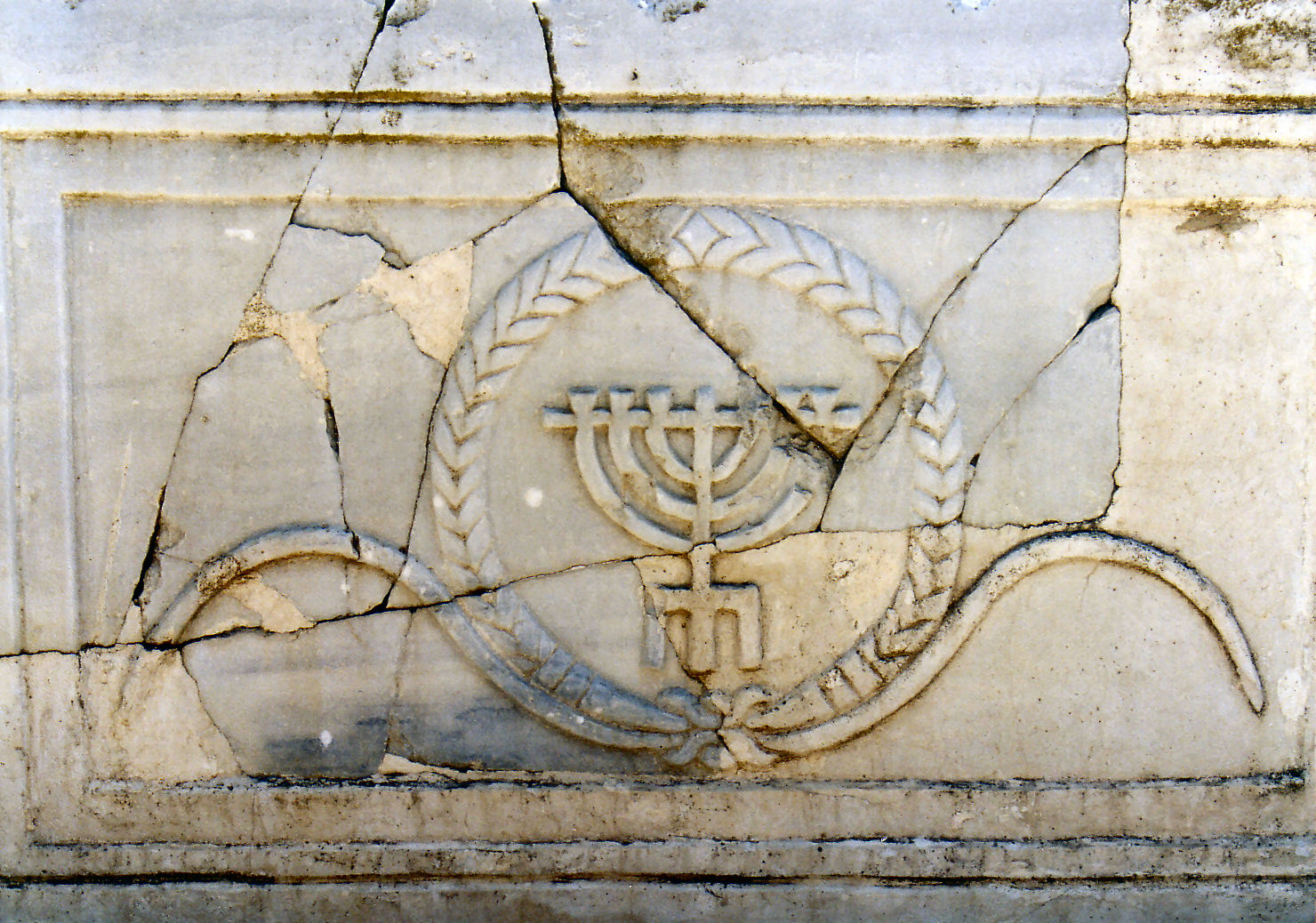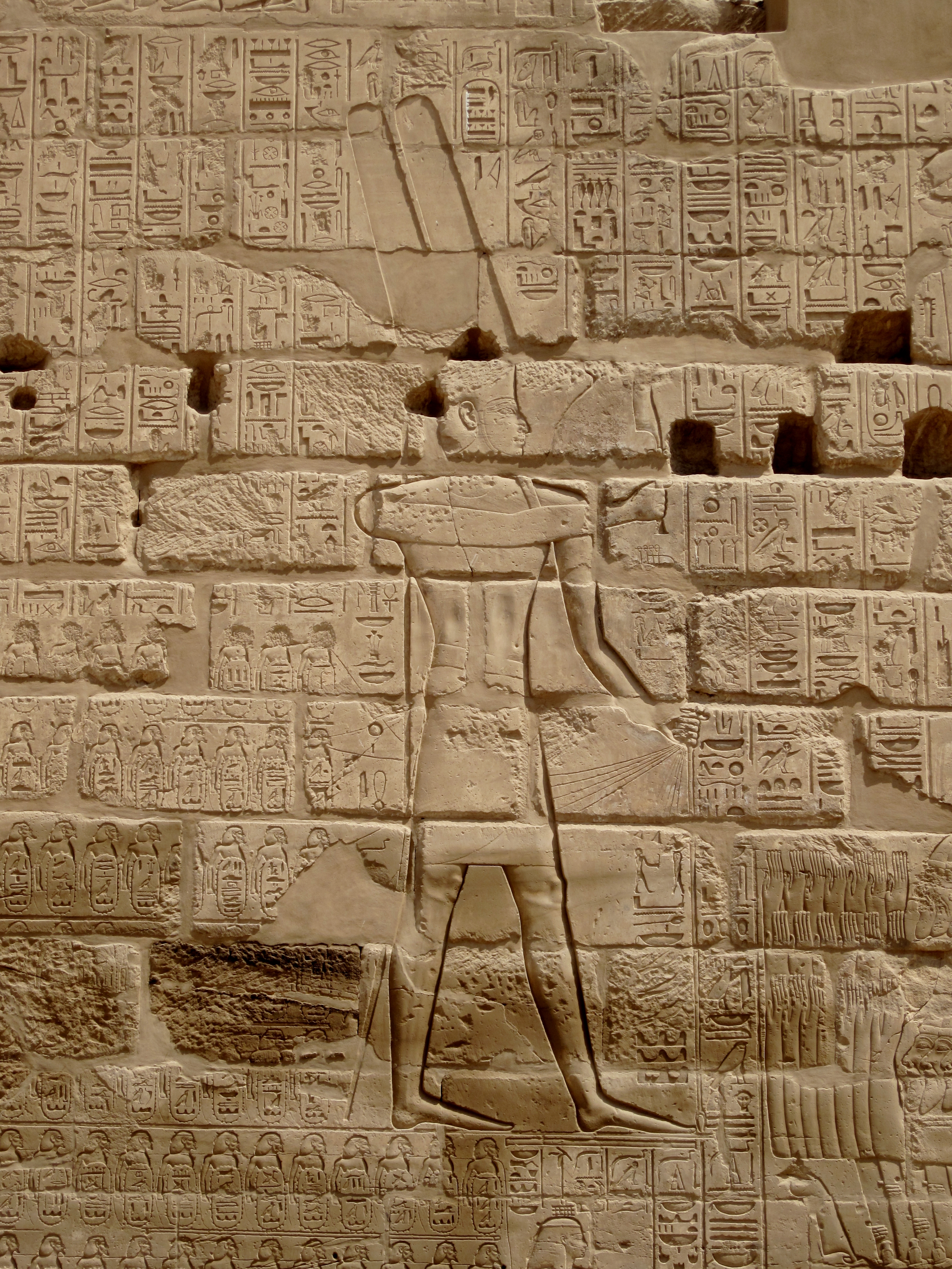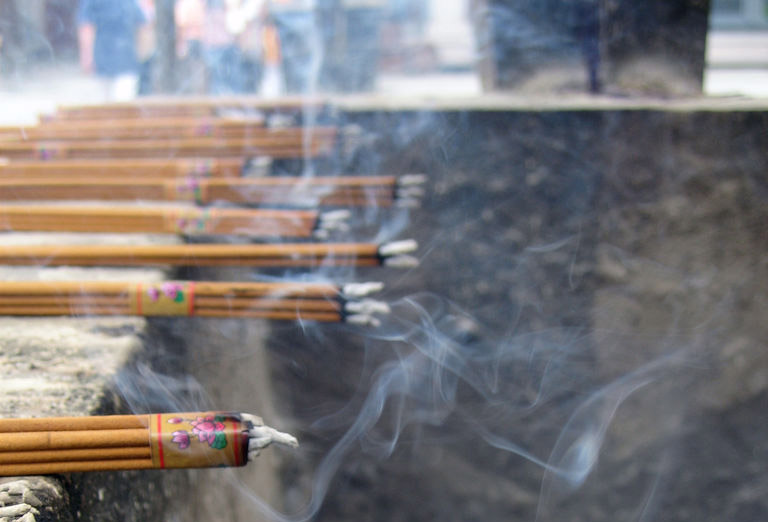|
Rehob
Tel Rehov ( he, תל רחוב) or Tell es-Sarem ( ar, تل الصارم), is an archaeological site in the Bet She'an Valley, a segment of the Jordan Valley, Israel, approximately south of Beit She'an and west of the Jordan River. It was occupied in the Bronze Age and Iron Age. The site is one of several suggested as Rehov (also Rehob), meaning "broad", "wide place", The oldest apiary discovered anywhere by archaeologists, including man-made beehives and remains of the bees themselves, dating between the mid-10th century BCE and the early 9th century BCE, came to light on the tell. In the nearby ruins of the mainly Byzantine-period successor of Iron Age Rehov, a Jewish town named Rohob or Roōb, archaeologists discovered the longest mosaic inscription found so far in the Land of Israel. Identification Tel Rehov does not correspond to the Hebrew Bible places named as Rehov, of which two were in the more westerly allotment of the Tribe of Asher, and one more northerly. [...More Info...] [...Related Items...] OR: [Wikipedia] [Google] [Baidu] |
Mosaic Of Rehob
The Mosaic of Reḥob, also known as the Tel Rehov inscription and Baraita of the Boundaries, is a late 3rd– 6th century CE mosaic discovered in 1973, inlaid in the floor of the foyer or narthex of an ancient synagogue near Tel Rehov, south of Beit She'an and about west of the Jordan River, containing the longest written text hitherto discovered in any mosaic in the Land of Israel, and also the oldest known Talmudic text. Unlike other mosaics found in the region, the Reḥob mosaic has very little in the form of ornate design and symmetric patterns, but is unique due to its inscription, acclaimed by scholars to be one of the most important epigraphical findings discovered in Israel in the last century. Its text sheds invaluable light on the historical geography (toponymy) of Palestine during the Late Roman and Byzantine periods, as well as on Jewish and non-Jewish ethnographic divisions in Palestine for the same periods and their relation to one another, specifically, on ... [...More Info...] [...Related Items...] OR: [Wikipedia] [Google] [Baidu] |
Bubastite Portal
The Bubastite Portal gate is located in Karnak, within the Precinct of Amun-Re temple complex, between the temple of Ramesses III and the second pylon. It records the conquests and military campaigns in c.925 BC of Shoshenq I, of the Twenty-second Dynasty. Shoshenq has been identified with the biblical Shishaq, such that the relief is also known as the Shishak Inscription or Shishaq Relief. History This gate was erected by the kings of the Twenty-second Dynasty of Egypt, also known as the "Bubastite Dynasty". It is located to the south-east side of the Temple of Ramesses III. Although Karnak had been known to Europeans since the end of the Middle Ages, the possible significance of the Bubastite Portal was not apparent prior to the decipherment of hieroglyphs. Jean-François Champollion visited Karnak in 1828, six years after his publication of the Rosetta Stone translation. In his letters he wrote: Description One facade shows King Sheshonq I, Teklot and Osorkon of the ... [...More Info...] [...Related Items...] OR: [Wikipedia] [Google] [Baidu] |
Beit She'an
Beit She'an ( he, בֵּית שְׁאָן '), also Beth-shean, formerly Beisan ( ar, بيسان ), is a town in the Northern District of Israel. The town lies at the Beit She'an Valley about 120 m (394 feet) below sea level. Beit She'an is believed to be one of the oldest cities in the region. It has played an important role in history due to its geographical location at the junction of the Jordan River Valley and the Jezreel Valley. The town's ancient tell contains remains beginning in the Chalcolithic period. It served as an Egyptian administrative center during the Late Bronze Age. During the Hellenistic period, the settlement was known as Scythopolis (Ancient Greek: ''Σκυθόπολις''). After the region came under Roman rule, Scythopolis gained imperial free status and was the leading city of the Decapolis. Later, under Byzantine rule, it served as the capital of Palaestina Secunda. Following the Arab conquest of the Levant, the city lost its prominence. T ... [...More Info...] [...Related Items...] OR: [Wikipedia] [Google] [Baidu] |
Shoshenq I
Hedjkheperre Setepenre Shoshenq I ( Egyptian ''ššnq''; reigned c. 943–922 BC)—also known as Shashank or Sheshonk or Sheshonq Ifor discussion of the spelling, see Shoshenq—was a pharaoh of ancient Egypt and the founder of the Twenty-second Dynasty of Egypt. Of Meshwesh ancestry, Shoshenq I was the son of Nimlot A, Great Chief of the Ma, and his wife Tentshepeh A, a daughter of a Great Chief of the Ma herself. He is presumed to be the Shishak mentioned in the Hebrew Bible, and his exploits are carved on the Bubastite Portal at Karnak. Chronology The conventional dates for his reign, as established by Kenneth Kitchen, are 945–924 BC but his time-line has recently been revised upwards by a few years to 943–922 BC, since he may well have lived for up to two to three years after his successful campaign in Canaan, conventionally dated to 925 BC. As Edward Wente of the University of Chicago noted (1976) on page 276 of his JNES 35 Book Review of Kitchen's study ... [...More Info...] [...Related Items...] OR: [Wikipedia] [Google] [Baidu] |
Tribe Of Asher
According to the Hebrew Bible, the Tribe of Asher was one of the Tribes of Israel descended from Asher (), the eighth son of Jacob. It is one of the ten lost tribes. Biblical narrative According to the biblical Book of Joshua, following the completion of the conquest of Canaan by the Israelite tribes, Joshua allocated the land among the twelve tribes. According to biblical scholar Kenneth Kitchen, one should date this conquest slightly after 1200 BC.Kitchen, Kenneth A. (2003), "On the Reliability of the Old Testament" (Grand Rapids, Michigan. William B. Eerdmans Publishing Company)() This is referred to as a 'late date' with the main alternative of around 1500 BC referred to as the 'early date' for both the Exodus and conquest of Canaan. Waltke, Bruce (1990), "The Date of the Conquest" (Westminster Theological Journal 52.2 (Fall 1990): 181-200./ref>In opposition to both of these views, many critical scholars holds that the conquest of Joshua as described in the Book of Joshua neve ... [...More Info...] [...Related Items...] OR: [Wikipedia] [Google] [Baidu] |
Israelite
The Israelites (; , , ) were a group of Semitic-speaking tribes in the ancient Near East who, during the Iron Age, inhabited a part of Canaan. The earliest recorded evidence of a people by the name of Israel appears in the Merneptah Stele of ancient Egypt, dated to about 1200 BCE. According to the modern archaeological account, the Israelites and their culture branched out of the Canaanite peoples and their cultures through the development of a distinct monolatristic—and later monotheistic—religion centred on the national god Yahweh.Mark Smith in "The Early History of God: Yahweh and Other Deities of Ancient Israel" states "Despite the long regnant model that the Canaanites and Israelites were people of fundamentally different culture, archaeological data now casts doubt on this view. The material culture of the region exhibits numerous common points between Israelites and Canaanites in the Iron I period (c. 1200–1000 BCE). The record would suggest that the Israe ... [...More Info...] [...Related Items...] OR: [Wikipedia] [Google] [Baidu] |
Land Of Israel
The Land of Israel () is the traditional Jewish name for an area of the Southern Levant. Related biblical, religious and historical English terms include the Land of Canaan, the Promised Land, the Holy Land, and Palestine (see also Israel (other)). The definitions of the limits of this territory vary between passages in the Hebrew Bible, with specific mentions in Genesis 15, Exodus 23, Numbers 34 and Ezekiel 47. Nine times elsewhere in the Bible, the settled land is referred as " from Dan to Beersheba", and three times it is referred as "from the entrance of Hamath unto the brook of Egypt" (1 Kings 8:65, 1 Chronicles 13:5 and 2 Chronicles 7:8). These biblical limits for the land differ from the borders of established historical Israelite and later Jewish kingdoms, including the United Kingdom of Israel, the two kingdoms of Israel (Samaria) and Judah, the Hasmonean Kingdom, and the Herodian kingdom. At their heights, these realms ruled lands with similar bu ... [...More Info...] [...Related Items...] OR: [Wikipedia] [Google] [Baidu] |
Jehu
) as depicted on the Black Obelisk of Shalmaneser III , succession = King of Northern Israel , reign = c. 841–814 BCE , coronation = Ramoth-Gilead, Israel , birth_date = c. 882 BCE , death_date = c. 814 BCE , burial_place = Samaria, Kingdom of Israel , predecessor = Jehoram , successor = Jehoahaz , issue = Jehoahaz , father = Jehoshaphat Jehu ( he, יֵהוּא, translit=Yēhūʾ, meaning " Yahu is He"; akk, 𒅀𒌑𒀀 ''Ya'úa'' 'ia-ú-a'' la, Iehu) was the tenth king of the northern Kingdom of Israel since Jeroboam I, noted for exterminating the house of Ahab. He was the son of Jehoshaphat, grandson of Nimshi, and possibly great-grandson of Omri, although the latter notion is not supported by the biblical text. His reign lasted for 28 years. William F. Albright has dated his reign to 842–815 BCE, while E. R. Thiele offers the dates 841–814 BCE. The principal source for the events of his reign comes from 2 Kings. ... [...More Info...] [...Related Items...] OR: [Wikipedia] [Google] [Baidu] |
Nimshi
Nimshi ( he, נִמְשִׁי ''Nīmšī''; Latin and Douay–Rheims: Namsi) is a character in the Hebrew Bible. He is mentioned in the Books of Kings and the Second Book of Chronicles as father, grandfather, or possibly a forebear of Jehu, the king of the Northern Kingdom of Israel (compare with ). History The Hebrew word ''ben'' () can mean both a literal "son", or a male descendant. The biblical text describes Jehu as either the "son of Nimshi" (''ben Nimshi''); or as the "son of Jehoshaphat" (''ben Yehoshafat''), who is himself called the "son of Nimshi". Some scholars have therefore taken the phrase to mean that Jehu was not the actual son of Nimshi, and that Nimshi was either the grandfather or ancestor of Jehu, or even that Jehu belonged to a ''clan'' named Nimshi. Another possibility is that "son of Jehoshaphat" was a later addition, in which case Nimshi would be the father of Jehu. Baruchi-Unna suggests that Nimshi was a son of King Omri and a brother of King Ahab. Jeh ... [...More Info...] [...Related Items...] OR: [Wikipedia] [Google] [Baidu] |
Altar
An altar is a Table (furniture), table or platform for the presentation of religion, religious offerings, for sacrifices, or for other ritualistic purposes. Altars are found at shrines, temples, Church (building), churches, and other places of worship. They are used particularly in paganism, Christianity, Buddhism, Hinduism, Judaism, modern paganism, and in certain Islam, Islamic communities around Caucasus, Caucasia and Anatolia, Asia Minor. Many historical-medieval faiths also made use of them, including the Religion in ancient Rome, Roman, Religion in ancient Greece, Greek, and Norse paganism, Norse religions. Etymology The modern English language, English word ''wikt:altar#English, altar'' was derived from Middle English ''wikt:alter#Latin, altar'', from Old English ''wikt:alter, alter'', taken from Latin ''wikt:altare#Latin, altare'' ("altar"), probably related to ''wikt:adolere#Etymology 2, adolere'' ("burn"); thus "burning place", influenced by ''wikt:altus#Latin, altus'' ( ... [...More Info...] [...Related Items...] OR: [Wikipedia] [Google] [Baidu] |
Incense
Incense is aromatic biotic material that releases fragrant smoke when burnt. The term is used for either the material or the aroma. Incense is used for aesthetic reasons, religious worship, aromatherapy, meditation, and ceremony. It may also be used as a simple deodorant or insect repellent. Incense is composed of aromatic plant materials, often combined with essential oils. The forms taken by incense differ with the underlying culture, and have changed with advances in technology and increasing number of uses. Incense can generally be separated into two main types: "indirect-burning" and "direct-burning". Indirect-burning incense (or "non-combustible incense") is not capable of burning on its own, and requires a separate heat source. Direct-burning incense (or "combustible incense") is lit directly by a flame and then fanned or blown out, leaving a glowing ember that smoulders and releases a smoky fragrance. Direct-burning incense is either a paste formed around a bamboo ... [...More Info...] [...Related Items...] OR: [Wikipedia] [Google] [Baidu] |
Abel-meholah
Abel-meholah ( he, אָבֵל מְחוֹלָה, ''Avel Mehola'') was an ancient city frequently mentioned in the Hebrew Bible (Old Testament of Christianity). It is best known for being the birthplace and residence of the prophet Elisha. It is traditionally located near the Jordan River, south of Beit-She'an. Mentions in the Bible When Gideon defeated the Midianites, some of them fled "as far as the border of Abel-meholah" (). The text indicates that Abel-meholah was seen as a region with a defined border, west of the Jordan River and south of Beit-She'an. Abel-meholah is mentioned the Book of Kings under the description of King Solomon's administration. Among Solomon's twelve governors, there is one Baana who is put in charge of several districts including the area "from Beth-She'an to Abel-meholah" (). Later in the Book of Kings, Elijah, who had fled fearing Queen Jezebel's wrath, is ordered by God at Mount Horeb to go back along the Jordan valley and "anoint Elisha son of Sh ... [...More Info...] [...Related Items...] OR: [Wikipedia] [Google] [Baidu] |



._Beisan_mound_LOC_matpc.17062.jpg)







